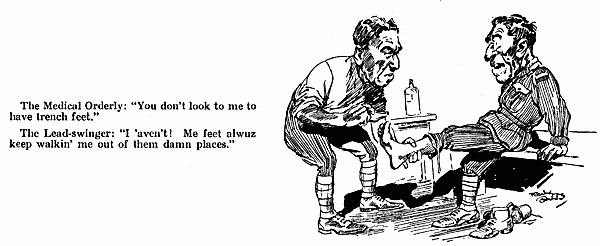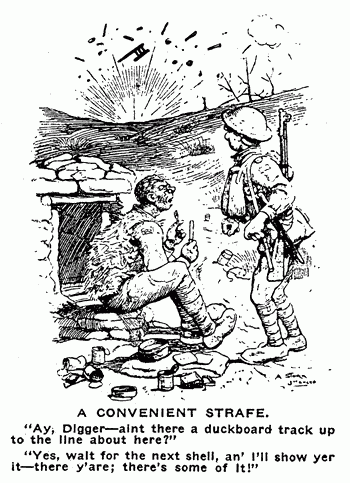1918: Trench Warfare - Hell on Earth
- 1918: Australians in France
- Battles
- Trench warfare

A cartoon by A. Storr, from the AIF publication Aussie, 1918. Film of trench-digging in 1918, from The Australians' Final Campaign in 1918
Although there had been some trench warfare in the American Civil War of 1861 - 65, and the Russian-Japanese War of 1904 - 05, it wasn't until the First World War that fixed trench warfare became the standard form of fighting. The trench system along the Western Front ran for approximately 475 miles, in an "S" shape across Europe, from the North Sea to Switzerland.
Trench warfare created a living environment for the men which was harsh, stagnant and extremely dangerous. Not only were trenches constantly under threat of attack from shells or other weapons, but there were also many health risks that developed into large-scale problems for medical personnel. Apart from the inescapable cold during the winters in France, trenches were often completely waterlogged and muddy, and crawling with lice and rats.
Diseases such as trench fever (an infection caused by louse faeces), trench nephritis (an inflammation of the kidneys), and trench foot (the infection and swelling of feet exposed to long periods of dampness and cold, sometimes leading to amputation) became common medical problems, and caused significant losses of manpower.

An aerial view of shell and bomb damaged battlefield and trenches in Belgium. Cartoon by Frank Dunne
Captain C.E.W. Bean, knee-deep in mud in a trench near Gueudecourt. He was later to write and edit the multi-volume official history of Australians in the First World War.
Australian ambulance workers near Bernafay, transporting men suffering from trench foot to hospital.


